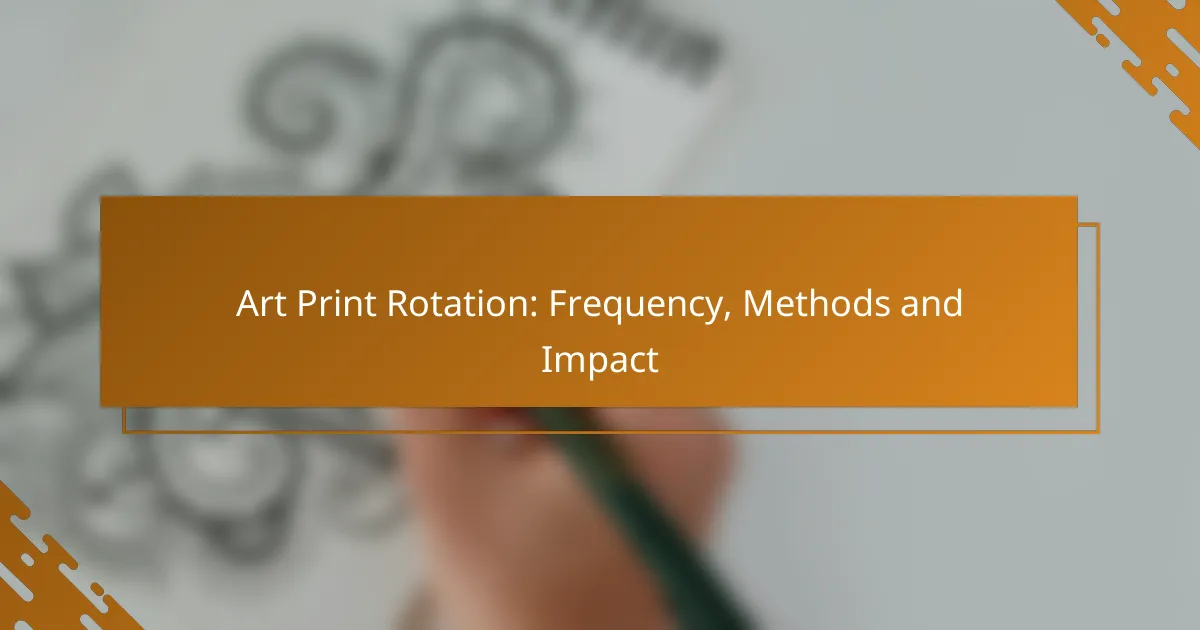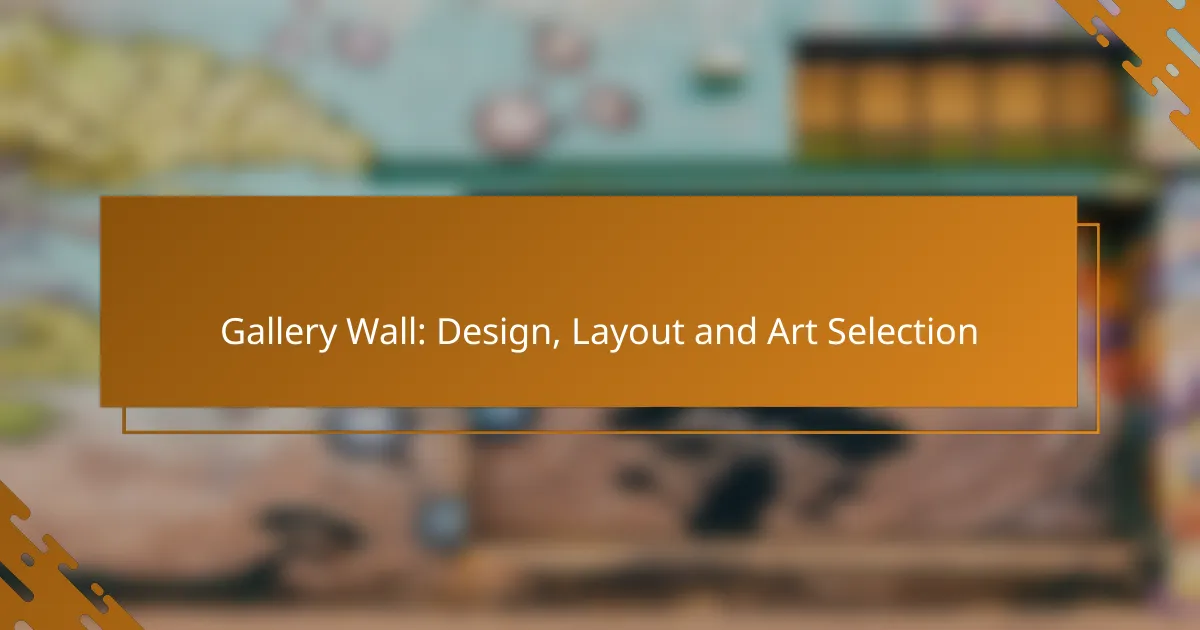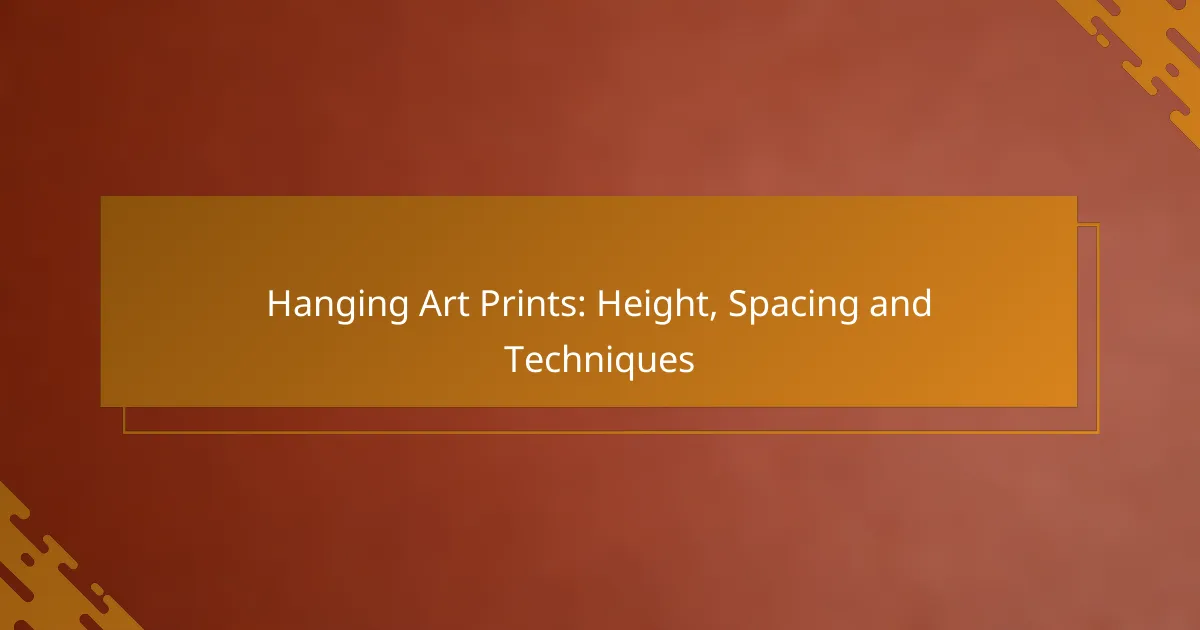Rotating art prints in your home is essential for creating a dynamic and inviting atmosphere. The frequency and methods of rotation can greatly influence the aesthetic impact and emotional response to your space, offering opportunities for creativity and personal expression.

How often should you rotate art prints in your home?
Rotating art prints in your home should be done regularly to maintain a fresh and engaging atmosphere. The frequency of rotation can vary based on personal preference, the type of environment, and the desired aesthetic impact.
Every season for fresh aesthetics
Rotating art prints every season allows you to align your decor with the changing moods and colors of nature. This method is ideal for those who enjoy seasonal themes, such as warm tones in autumn or cool hues in winter.
Consider selecting a few key pieces that reflect the season’s essence. For example, you might display floral prints in spring and landscapes in summer. This approach keeps your space feeling vibrant and relevant throughout the year.
Monthly for dynamic environments
Monthly rotations can create a dynamic and ever-evolving environment, perfect for those who thrive on change. This frequency is suitable for spaces like home offices or creative studios where inspiration is key.
To implement this, you could set a specific day each month to refresh your art. Choose a mix of styles and themes to keep the atmosphere lively. Just be mindful of the time and effort required to change the prints frequently.
Quarterly for minimalistic styles
For minimalistic styles, rotating art prints quarterly strikes a balance between freshness and simplicity. This approach allows you to maintain a clean aesthetic while still introducing new visuals periodically.
When rotating quarterly, select a few standout pieces that can complement your overall design without overwhelming the space. This method is particularly effective in modern or minimalist homes where less is often more.

What methods can be used for art print rotation?
Art print rotation can be achieved through various methods that enhance the display and enjoyment of artwork. Effective techniques include gallery wall arrangements, framed art swap systems, and digital art displays, each offering unique benefits and considerations.
Gallery wall arrangements
Gallery wall arrangements involve grouping multiple art prints together on a single wall, creating a cohesive visual impact. This method allows for easy rotation by simply swapping out individual pieces while maintaining the overall aesthetic. Consider using a consistent frame style or color palette to unify the display.
When planning a gallery wall, measure the available space and lay out the arrangement on the floor before hanging. Aim for a balanced look by varying the sizes and orientations of the prints. A common approach is to leave a gap of about 5 to 10 cm between each frame for a clean appearance.
Framed art swap systems
Framed art swap systems involve using interchangeable frames that allow for quick changes of artwork. This method is particularly useful for those who want to frequently update their displays without the hassle of re-hanging. Choose frames that are easy to open and close, ensuring a smooth swapping process.
Consider investing in a few high-quality frames that fit various artworks, allowing for flexibility in rotation. Keep a selection of prints stored safely, and establish a regular schedule for swapping out pieces, such as monthly or seasonally, to keep the display fresh and engaging.
Digital art displays
Digital art displays utilize screens to showcase a rotating selection of artworks, providing an innovative way to enjoy multiple pieces without physical limitations. These displays can be programmed to change images at set intervals, allowing for a dynamic viewing experience.
When choosing a digital display, consider factors such as screen size, resolution, and ease of use. Many digital frames allow for remote updates, making it simple to refresh the collection. This method is particularly advantageous for those with limited wall space or who want to feature a larger variety of art without clutter.
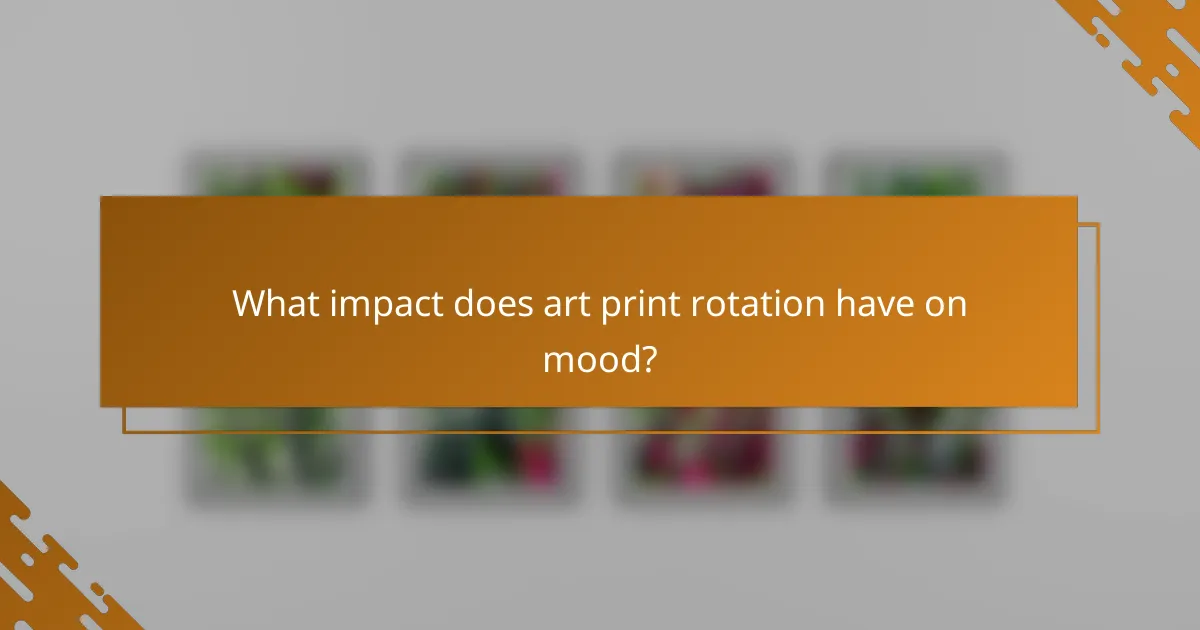
What impact does art print rotation have on mood?
Art print rotation positively influences mood by introducing fresh visual stimuli that can uplift emotions and inspire creativity. Regularly changing artwork can create a more engaging environment, reducing monotony and enhancing overall well-being.
Enhances creativity and inspiration
Rotating art prints can stimulate creativity by exposing viewers to new ideas and perspectives. Different styles, colors, and themes can spark inspiration, encouraging innovative thinking and artistic expression.
For example, displaying abstract art one month and landscapes the next can shift your mindset and inspire different creative pursuits, whether in writing, painting, or other forms of expression.
Reduces visual fatigue
Over time, constant exposure to the same artwork can lead to visual fatigue, where the brain becomes desensitized to familiar images. By rotating art prints, you can keep your visual environment fresh and engaging, preventing this fatigue.
A good practice is to change your art every few months or seasonally, allowing your space to feel new and invigorating while maintaining interest and engagement with your surroundings.
Creates a dynamic living space
Art print rotation contributes to a dynamic living space that reflects personal growth and changing tastes. A varied art collection can create a more vibrant atmosphere, making your home feel alive and inviting.
Consider incorporating seasonal themes or rotating prints that resonate with current moods or events, such as bright colors in spring or cozy, warm tones in winter. This approach not only enhances aesthetics but also fosters a deeper emotional connection to your space.
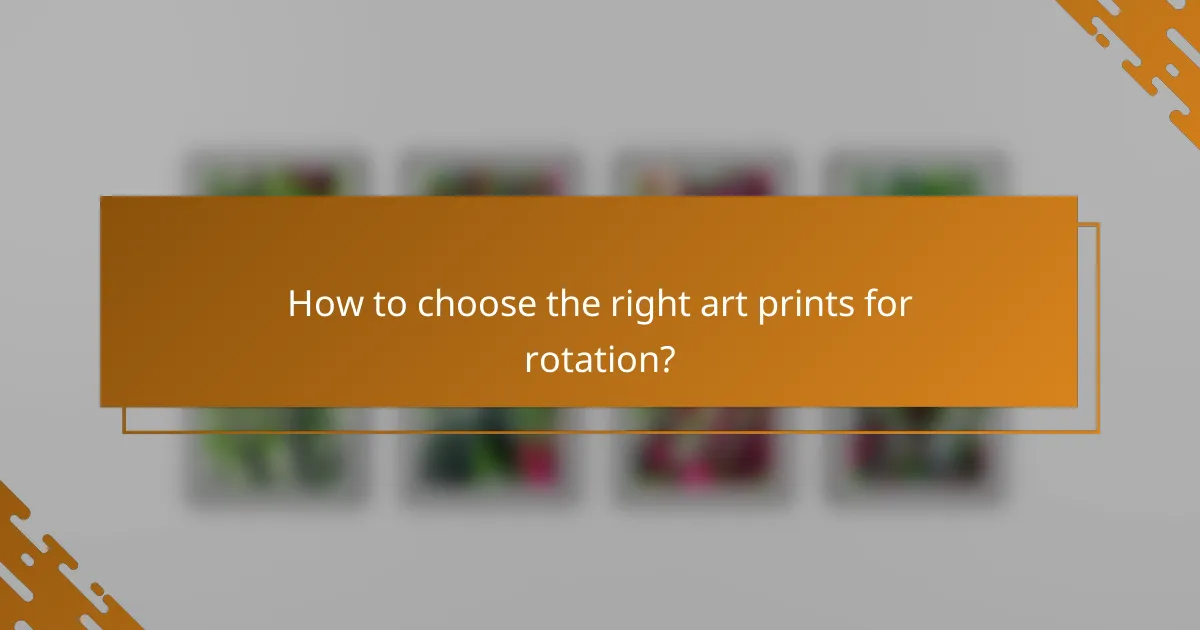
How to choose the right art prints for rotation?
Selecting the right art prints for rotation involves considering personal preferences, seasonal aesthetics, and the physical space available. By aligning your choices with these factors, you can create a dynamic and visually appealing environment that reflects your style and adapts to different times of the year.
Consider personal taste and style
Your personal taste and style are crucial in choosing art prints for rotation. Think about the themes, colors, and artistic styles that resonate with you. Whether you prefer modern abstracts, classic landscapes, or vibrant pop art, your selections should reflect your unique aesthetic.
To narrow down your options, create a mood board or digital collection of prints that inspire you. This can help clarify your preferences and guide your future selections.
Assess seasonal themes and colors
Seasonal themes and colors can significantly influence your art print choices. For instance, warm tones and nature-inspired prints may be more suitable for fall, while bright, airy designs can enhance a summer vibe. Consider rotating your prints to match the changing seasons for a fresh look throughout the year.
To make this easier, you can categorize your prints by season and store them accordingly. This way, you can quickly swap out pieces as the seasons change, keeping your space feeling current and inviting.
Evaluate space and size compatibility
When choosing art prints for rotation, it’s essential to evaluate the space and size compatibility of each piece. Measure your wall space and consider the scale of the prints you want to display. A large print can serve as a focal point, while smaller pieces can be grouped for a gallery effect.
As a rule of thumb, aim for a balanced arrangement. For example, if your wall is wide, consider using multiple smaller prints or one large statement piece. Always ensure that the prints you choose fit well within your designated area to maintain visual harmony.

What are the benefits of rotating art prints?
Rotating art prints offers numerous benefits, including enhanced visual interest and the chance to refresh your space. Regularly changing artwork can keep your environment dynamic and engaging, while also allowing you to explore diverse artistic expressions.
Increased engagement with artwork
Frequent rotation of art prints can significantly boost engagement with the pieces displayed. When viewers encounter new artwork regularly, they are more likely to take notice and appreciate the details and themes presented. This heightened interaction can lead to deeper emotional connections with the art.
To maximize engagement, consider rotating prints every few months. This timeframe allows for enough exposure to each piece while keeping the environment fresh and stimulating.
Opportunity to showcase new artists
Rotating art prints provides an excellent platform to highlight emerging artists. By featuring their work, you not only support their careers but also introduce unique perspectives and styles to your collection. This can enrich your aesthetic experience and promote a diverse range of artistic voices.
Consider collaborating with local galleries or art fairs to discover new talent. This approach not only enhances your collection but also fosters community connections within the art scene.
Flexibility in home decor
Regularly changing art prints allows for greater flexibility in home decor. As trends and personal tastes evolve, rotating artwork can help maintain a cohesive look that reflects your current style. This adaptability can make it easier to transition between seasonal themes or special occasions.
To effectively manage this flexibility, establish a rotation schedule and keep a selection of prints that complement various color schemes and styles. This strategy ensures that your decor remains fresh and aligned with your evolving preferences.
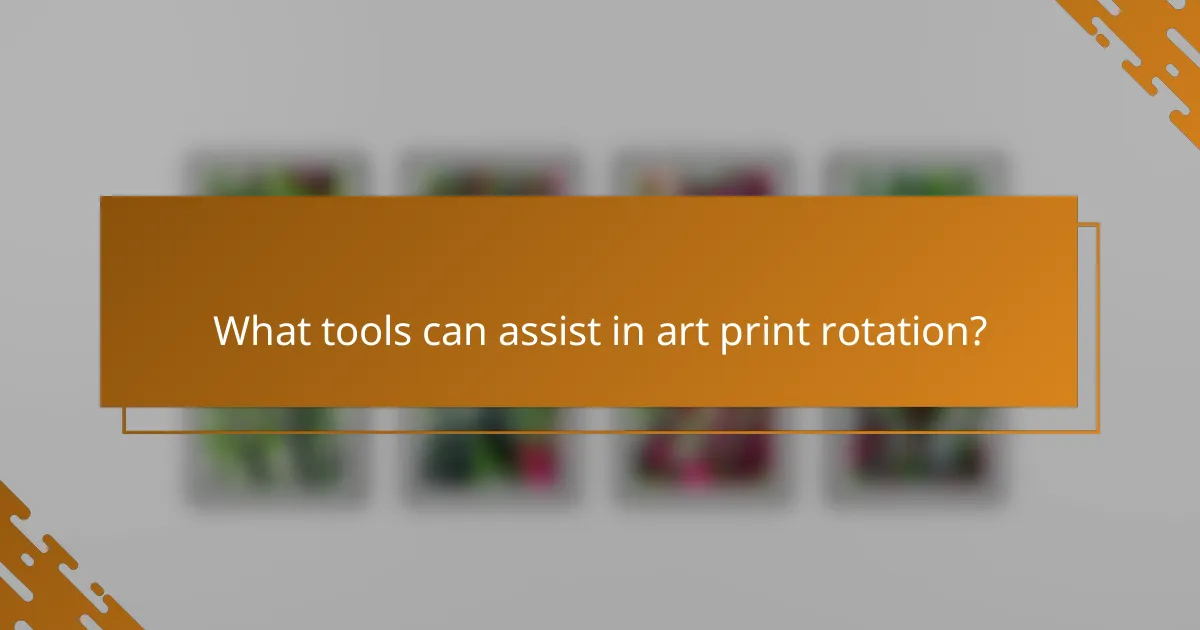
What tools can assist in art print rotation?
Several tools can help streamline the process of art print rotation, making it easier to refresh your space regularly. These tools range from software solutions to physical display options, each offering unique benefits for managing and showcasing art effectively.
Art display software
Art display software allows users to organize and manage their art collections digitally. These programs often include features for cataloging artwork, tracking display history, and scheduling rotation dates, which can enhance the overall experience of displaying art.
When choosing art display software, consider options that integrate well with your existing devices and provide user-friendly interfaces. Some popular choices include ArtBinder and Artwork Archive, which cater to both personal and professional needs.
Magnetic frames
Magnetic frames are a practical solution for quickly changing art prints without damaging the artwork or walls. These frames use magnets to hold prints securely, allowing for easy swapping whenever you want to refresh your display.
When using magnetic frames, ensure that the frame size matches your prints and that the magnets are strong enough to hold the artwork in place. This method is particularly useful for frequently changing displays in homes or galleries.
Art rotation apps
Art rotation apps are designed specifically to assist users in planning and executing art rotations. These apps can send reminders for when to change out pieces and may even suggest new arrangements based on your preferences.
Some popular art rotation apps include Artly and ArtMatic, which offer features like customizable rotation schedules and visual previews of your space. When selecting an app, look for one that aligns with your specific needs and provides an intuitive user experience.
